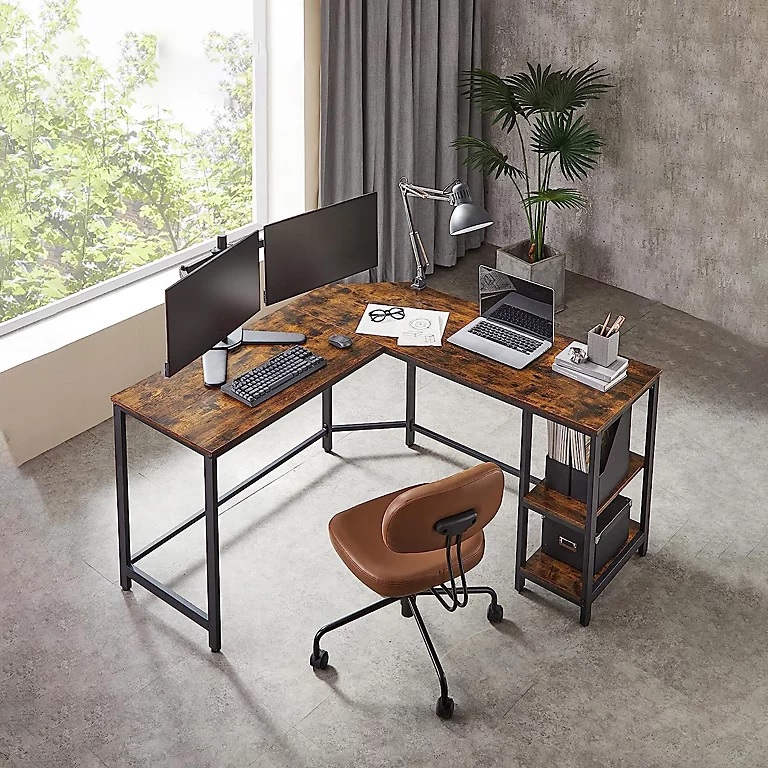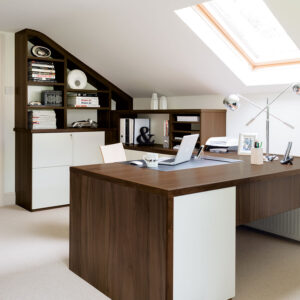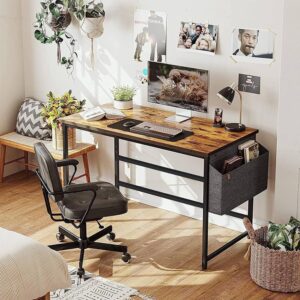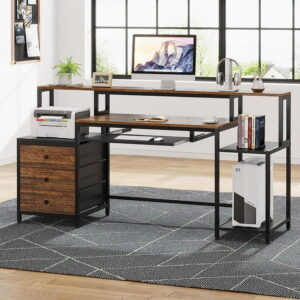Home Working Office And Computer Desk
Choosing the Ideal Work Area
When setting up your home office, focus on creating a functional and comfortable workspace. Consider these key points:
Positioning for Visual Comfort
- Place your desk where you can enjoy a pleasant view, like near a garden or window. This helps improve mood, lower stress, and boost productivity. Choose a spot with soft, natural light from a north or south-facing window to reduce glare.
Video Conference Setup
- Position your desk for a professional video conference background. A clean, neutral setting works best. Avoid sitting directly in front of a window to prevent glare on your screen.
Lighting Tips
- Good lighting is essential. While natural light is ideal, its direction matters—east and west-facing windows may cause glare at certain times. Use curtains or blinds if needed. Combine general, task, and natural lighting for a balanced and comfortable workspace.
Reducing Noise
- Minimize distractions by soundproofing your workspace with materials like foam or wool. This keeps out street noise or household sounds and helps you concentrate better.
Space and Movement
- Ensure your desk area has enough room to move around freely. Leave at least 36 inches behind the desk for your chair and 30 inches on each side for comfort. A desk at least 48 inches (120 cm) wide is recommended, though 60 inches (150 cm) or more is better for comfort.
Managing Distractions
- Choose a quiet area away from high-traffic zones or noisy spots. This will help you focus and work without interruptions.
Staying Organized
- Keep your workspace tidy with shelves, cabinets, or filing systems. Having essential items within reach, like your inbox or files, makes it easier to stay productive and clutter-free.
Desk Layout Options
- Desk by the Window: Offers natural light and a scenic view, creating a calming environment.
- Desk Facing the Door: Best for roles involving meetings, as it creates an open, welcoming feel.
- Perpendicular Desks: Useful for flexibility, such as adding a reading area or a neat backdrop for video calls.
Comfort and Ergonomics
- Invest in an adjustable chair and set your desk height between 28-30 inches (70-75 cm) for proper posture. This reduces strain and keeps you comfortable during long hours of work.
Selecting the Right Equipment
Setting up a home office requires choosing equipment that boosts both comfort and productivity.
- Computer: Choose a computer with enough processing power, memory, and storage to meet your needs. Look for a high-performance processor, ample RAM, and SSD storage to ensure smooth operation.
- Monitors: Use high-resolution monitors for clear visuals. A dual-monitor setup can enhance multitasking efficiency. Monitors with adjustable height, tilt, and swivel features improve ergonomic comfort.
- Ergonomic Chairs: Select a chair with adjustable height, armrests, and backrest. Make sure it provides lumbar support and can recline between 100-110° to reduce spinal strain. Casters allow easy movement around the workspace.
- Height-Adjustable Desks: A height-adjustable desk supports both sitting and standing, helping to prevent issues like carpal tunnel syndrome and back pain. The desk should have enough space—ideally double the user’s width—to keep it uncluttered.
- Laptop Stand: A laptop stand raises the screen to eye level, which promotes better posture and eases neck strain.
- Ergonomic Keyboards and Mice: Opt for ergonomic keyboards and mice to reduce wrist and hand strain. A wireless mouse and a curved or split keyboard offer more comfort during extended typing sessions.
- Task Lighting: Good task lighting is essential. Choose LED desk lamps with adjustable brightness and auto-dimming to reduce glare and ease eye strain.
- Office Storage: Use storage solutions like bookcases and filing cabinets to keep your workspace organized based on the size of your office and your storage needs.
Optimizing Desk Setup for Productivity
Create a workspace that is both functional and organized to improve productivity and well-being.
Dual Monitor Setup for Better Efficiency
Using two or more monitors can help you work more efficiently. Multiple screens let you spread out tasks, reducing the need to constantly switch between tabs or windows. For example, you can dedicate one screen to your main task, another to emails or browsing, and a third to reference materials. This setup can increase productivity by up to 30%, especially for roles like programming, design, and trading.
Keep Essentials Within Reach
Arrange frequently used items like your mouse, keyboard, notepads, and pens within easy reach. This setup reduces unnecessary movement, keeping you focused on your tasks. Ensure all critical tools are accessible to maintain a smooth workflow.
Clear Desk and Tidy Cables
A clutter-free desk boosts focus and mental clarity. At the end of each day, tidy your desk to prepare for a fresh start. Manage cables with ties, clips, or trays under your desk to keep things organized and reduce distractions.
Prioritize Ergonomics and Comfort
Choose an ergonomic chair with lumbar support and consider accessories like wrist rests and footrests to promote good posture. Proper ergonomics prevent discomfort and fatigue from long periods of sitting. Use an adjustable desk and position your monitor at eye level to avoid strain on your eyes and neck. If possible, switch between sitting and standing with an adjustable desk for better posture.
Ensure Proper Lighting
Place your desk near a window to benefit from natural light, which enhances mood and productivity. For evening work, use adjustable lamps to provide sufficient lighting and reduce eye strain. Good lighting is essential for focus and comfort.
Take Regular Breaks and Stay Organized
Short breaks are key to maintaining productivity. Use techniques like the Pomodoro method, where you work for 25 minutes and then rest for 5 minutes. Stay on top of tasks by using a to-do list or project management tool to keep your work organized and manageable.
By implementing these strategies, you can create a workspace that promotes comfort, efficiency, and productivity.
Utilizing Vertical Space and Storage
Maximizing vertical space in your home office is a great way to keep your desk organized and free up workspace. Using wall-mounted storage and creative organizing ideas lets you make the most of your space while keeping it tidy and visually appealing.
Wall-mounted Shelves
Wall-mounted shelves are a great way to store books, office supplies, and personal items without taking up desk space. Floating shelves provide a sleek look, while bracket shelves support heavier items. These shelves can also hold family photos, folded clothes, or decor, keeping your workspace clean and organized.
Hanging Organizers
Hanging closet organizers work well in home offices too. These organizers have compartments for storing office supplies, files, and small items. If you have limited space, choose slim hanging shelves or go for larger ones to hold bulkier items like sweaters or office equipment. These organizers keep everything accessible without using up floor space.
Filing Cabinets and Drawers
Filing cabinets help keep important documents organized. Look for sturdy cabinets that can hold your files. Stackable drawers or bins are also useful for organizing smaller office supplies like pens, notepads, and stationery. These options ensure your essentials are easy to access and stay neatly stored.
Desk Organizers and Bins
Use desk organizers and bins to keep your desk tidy. Clear bins or baskets help you identify contents quickly, while wire baskets can be hung on the wall or placed on shelves for smaller items. These solutions help you maintain a clean and organized desk so you can focus on your work.
Pegboard for Easy Access
A pegboard mounted on the wall is a great way to store items like headphones, pens, and other frequently used tools. Pegboards are inexpensive and versatile, keeping everything within easy reach. You can customize the board with hooks and organizers to fit your needs, making it a practical addition to any office.
Over-the-Door Storage
Over-the-door hooks and racks are perfect for storing bags, jackets, or extra office supplies. These organizers are especially useful in smaller spaces, where floor area is limited. Over-the-door storage adds space for items like shoes, accessories, or cleaning supplies without using up floor space.
Wall-mounted Furniture
Consider wall-mounted tables or desks as a space-saving solution. These can be folded away when not in use, freeing up floor space and providing flexibility. Wall-mounted furniture is ideal for home offices where you need a functional workspace without sacrificing space.
Vertical Storage Systems: ALGOT and Elfa
Systems like IKEA’s ALGOT (now known as BOAXEL) and The Container Store’s Elfa system are effective for maximizing vertical storage in home offices. These systems let you store office supplies, books, and equipment up to the ceiling, creating an organized and efficient space. The modular design allows you to customize storage and rearrange it when needed.
By using these vertical storage solutions, you can reduce clutter, free up your desk, and create a productive and organized home office.
Designating Activity Zones
Creating a functional and organized home office involves designating specific activity zones. This approach keeps your workspace tidy and enhances productivity. Here are key zones to consider:
Focused Work Zone
The focused work zone is a distraction-free area for tasks needing deep concentration. This space should have a comfortable desk, ergonomic chair, and essential tools like a computer, notebooks, and minimal supplies. The aim is to reduce distractions and boost focus.
Collaboration Zone
A collaboration zone supports teamwork and meetings. Set up an area with comfortable seating and space for discussions. Equip it with tools such as whiteboards, video conferencing setups, and large screens for presentations. This zone is great for brainstorming and group projects.
Learning Zone
Create a learning zone to support continuous skill development. Include a large monitor for training videos, shelves for books, and access to printers and scanners. This quiet and comfortable space helps maintain focus during learning activities.
Brainstorming Zone
A brainstorming zone fosters creativity and idea generation. Include a large whiteboard, comfortable seating, and soundproofing to enhance focus. This space is ideal for meetings or individual brainstorming sessions.
Hot Desk Zone
If multiple people share the home office or a communal vibe is needed, a hot desk zone is practical. Include adjustable desks, media ports, and charging stations. This zone offers flexibility, collaboration, and a change of scenery for casual meetings.
Utility Zones
Add utility zones such as a beverage station for coffee or tea to keep the workspace organized. A quiet zone can also help with uninterrupted work, using soundproof walls and cozy seating to maintain peace.
By designing these activity zones, you’ll boost efficiency and organization, giving each task a dedicated space to improve productivity.
Ergonomic and Comfort Considerations
When setting up a home office, choosing ergonomic furniture is essential for comfort and productivity. The right furniture reduces strain and improves well-being during long hours of work.
Choose Ergonomic Furniture
- Liberty Task Chair by Humanscale: This chair provides automatic lumbar support, adjusting to each user’s back needs for maximum comfort.
- Freedom Office Task Chair: This chair combines comfort, style, and adjustability and is easily customized, helping maintain a healthy posture.
Adjustable Chairs for Comfort
- Onda Mid Back Office Chair: Known for adjustability and support, it’s ideal for those seeking a flexible seating experience.
- Ricari Office Massage Chair: Merges ergonomic design with massage functions to boost comfort and productivity during long work hours.
Height-Adjustable Desks
- BodyBilt Desks: Offers adjustable heights to keep a comfortable and ergonomic posture.
- Eureka Ergonomic Desks: These desks combine modern and classic designs with adjustable features to support better posture and reduce strain.
Add Exercise Equipment for a Healthier Workspace
- Standing Desks: Alternating between sitting and standing can improve circulation and counteract sedentary habits. Options from Herman Miller and Progressive Desk provide ergonomic standing desk solutions.
- Balance Boards: Suitable for sitting or standing, these boards help engage the core and improve balance, supporting physical health.
- Small Treadmills: Using a treadmill while working promotes physical activity and offsets long hours at the desk.
Additional Ergonomic Accessories
- Beuler Laptop Stand: This stand allows for a better screen angle, reducing neck and wrist strain.
- TravelLite Seat Cushion: Adds comfort and support, especially on hard chairs, for extended sitting periods.
By adding ergonomic furniture, adjustable chairs, height-adjustable desks, and exercise equipment, you can create a workspace that’s comfortable and tailored to your needs, promoting both comfort and productivity.
Personalizing Your Space
Design your home office and computer desk to reflect your personality while improving functionality and comfort.
Choose Colors That Suit Your Workspace
- Blue: Use calming blue shades on walls or ceilings to boost focus and dependability, especially for analytical tasks.
- Green: Add green with plants, desk chairs, or accents like floral wallpaper to improve clarity and reduce eye strain.
- Yellow: Include small yellow accents in furniture or decor to spark creativity and positivity. Avoid overuse to prevent overstimulation.
- Orange: Use small orange details like a pocket door or drawers to add energy and enthusiasm.
Add Inspiring Decor
- Artwork: Place inspiring art, like a statement piece above a bookshelf, to encourage creativity.
- Photos: Showcase personal photos on a gallery wall or an inspiration board to create a sense of belonging.
- Motivational Quotes: Display quotes on a memo board or as wall decor to inspire focus and drive.
Use Greenery for a Relaxing Atmosphere
- Snake Plants: These low-maintenance plants improve air quality, making them perfect for professionals.
- Aloe: Easy to care for and useful as a natural remedy for burns.
- English Ivy: Enhance elegance by placing it in decorative planters.
Optimize Lighting for Better Productivity
- Natural Light: Position your desk to take advantage of daylight. Use bright area rugs to reflect light and create an open feel.
- Desk Lamps: Select lamps with warm light to create a cozy atmosphere, especially in smaller spaces.
Choose Comfortable and Practical Furniture
- Ergonomic Chairs: Pick a desk chair that supports comfort, like a swivel chair or a plush leather armchair.
- Extra Seating: Add a sofa for a relaxation zone, which is especially useful in multipurpose rooms.
By carefully choosing colors, decor, plants, lighting, and furniture, you can create a workspace that enhances comfort and productivity.
Maximizing Space Efficiency
Use L-Shaped Desks
L-shaped desks add more surface area and let you divide tasks into zones. They make it easy to access essentials like computers, phones, printers, and stationery while using corner spaces well.
Corner Workstations
Corner desks, such as the Pepper corner desk from Habitat, fit neatly into corners and include built-in storage. They come in various colors to match different home office styles.
Wall-Mounted Desks
Wall-mounted desks, like the IKEA Norberg drop-leaf desk, are compact options for small spaces. These designs fold flat against the wall when not in use, keeping the workspace tidy and efficient.
Vertical Storage Solutions
Make use of vertical space with ladder desks, floating shelves, or bracketed shelving. For example, a ladder desk or floating shelves in a closet office can organize essentials and keep the workspace clutter-free.
Multi-Purpose Furniture
Choose furniture with multiple uses, such as side tables that double as desks. This helps maintain a clean look while preventing overcrowding, especially in guest bedroom offices.
Under-Stairs Spaces
Turn the area under stairs into a workspace by adding a simple desk with metal legs and custom storage. This setup hides clutter and keeps files organized.
Fold-Away Offices
Fold-away offices are ideal for spaces with multiple uses. They transform from full workstations to discreet furniture, like console tables, once the workday ends.
Pegboards and Wall Organizers
Pegboards, like the customizable IKEA Skadis, or wall organizers can hold office supplies while saving desk space. Spray-painted accessories on pegboards can also add a stylish touch.
Compact Desk Designs
Compact desks, such as the MICKE Corner Workstation, are great for small spaces. They include built-in storage to help keep items tidy and surfaces clear.
Attic Eaves and Floating Desks
Place a desk under attic eaves for occasional use, or install a floating desk in bedrooms. These setups save space and can double as dressing tables.
Storage from Floor to Ceiling
Maximize wall space with floor-to-ceiling storage. Use IKEA spice racks as slim shelves, and store less-used items near the ceiling to keep the workspace organized. “`
Outdoor and Portable Options
Creating an effective outdoor home office requires careful selection of ergonomic and portable elements. Here’s an overview of the key ideas:
Ergonomic and Weather-resistant Furniture
- Choose weather-resistant desks and chairs for durability and comfort. The materials should withstand various weather conditions.
Screen and Noise Management
- Anti-glare screen protectors improve screen visibility in sunny areas.
- Use Bluetooth headphones to block outdoor noise and help you focus.
Portable Equipment
- Select lightweight, compact gear, such as foldable desks and portable chairs, for easy setup and mobility.
Innovative Outdoor Workspaces
- Portable balcony desks are ideal for small spaces and those who move frequently. They are compact and foldable.
- Consider hammocks or treehouses for a unique and relaxing workspace.
Dedicated Outdoor Offices
- Transform a backyard shed into a private office by adding insulation, proper lighting, and comfortable furniture.
- Invest in garden office pods or prefab office pods for a modern setup with insulation and air conditioning.
Enhancing Environment and Privacy
- Create patio workspaces with a canopy to reduce glare. Add plants and decor for a calming atmosphere.
- Use plants or decorative screens for privacy and to reduce noise, creating a distraction-free zone.
Technology and Sustainability
- Ensure reliable internet with a Wi-Fi extender and secure, weather-resistant electrical setups.
- Use sustainable materials, like bamboo and recycled wood, and include LED lighting for an eco-friendly office.
Customization and Climate Considerations
- Adapt spaces, like summerhouses, with multifunctional furniture, such as fold-down desks. Use blinds for light control.
- Address climate control with heaters in winter and ventilation in summer to ensure year-round comfort.
Themed Desk Setups
A themed desk setup can transform your workspace, reflecting your style and boosting productivity. Whether you prefer vintage charm, modern gaming, or natural tranquility, there are many ways to make your home office unique. Here are some creative ideas for different themes.
Classic Academic Theme
For those who love a traditional and scholarly feel, a classic academic desk setup is ideal. This theme uses dark wood and vintage accessories for a nostalgic and intellectual look.
- Dark Wood Furniture: Choose dark wooden desks, shelves, and chairs for a refined, academic vibe.
- Classic Books: Display leather-bound classics or vintage textbooks on shelves or bookcases.
- Vintage Accessories: Add old-fashioned lamps, globes, and antique writing tools to complete the classic look.
- Color Scheme: Use muted tones like dark wood, brown leather, and shades of green to create a traditional feel.
Anime and Manga-Inspired Desk
Anime and manga fans can create an immersive, colorful desk setup filled with themed decor.
- Bright Accessories: Use colorful pens, sticky notes, and highlighters to add fun to your desk.
- Figurines: Showcase figures or collectibles from your favorite anime or manga series.
- Wall Art: Hang posters or prints of your favorite characters above your desk for added flair.
- Themed Stationery: Use notebooks, journals, and stationery inspired by your favorite series.
Gaming-Themed Desk Setup
A gaming-themed desk is perfect for those who love video games, making the workspace more exciting and engaging.
- Gaming Decor: Add controller-shaped organizers, pixel art, and game character figurines.
- LED Lighting: Use LED strips or lamps designed with gaming elements for dynamic lighting.
- Collectibles: Display rare game editions, figurines, or themed mugs to showcase your favorites.
- Wall Art: Hang posters of game maps, characters, or memorable scenes for a stronger gaming atmosphere.
Futuristic Desk Setup
If you love technology and innovation, a futuristic desk setup offers sleek lines, metallic accents, and the latest gadgets.
- High-Tech Elements: Use metallic pens, sleek paperweights, or glow-in-the-dark decor for a modern feel.
- Space Decor: Add star maps, galaxy prints, or spaceship models to enhance the futuristic theme.
- Smart Gadgets: Include smart lamps, wireless chargers, and advanced peripherals for a cutting-edge workspace.
- Color Palette: Choose metallic shades like chrome, silver, and black, paired with deep blues and purples.
Seasonal and Personalized Desk
A personalized desk setup with seasonal decorations or meaningful items can make your workspace more inspiring.
- Seasonal Decor: Update your desk with mini pumpkins for autumn, string lights for winter, or heart-shaped accents for Valentine’s Day.
- Family Photos: Display photos of loved ones or memorable moments for a personal touch.
Beach and Travel-Inspired Desk
Bring a relaxed, calming vibe to your workspace with beach or travel-themed elements.
- Coastal Theme: Use cane furniture, mini palm plants, and weathered wood for a beachy look.
- City Vibes: Incorporate artwork of your favorite city or landmarks to bring a travel spirit into your space.
- Color Palette: Stick to light, airy colors and natural textures for a soothing environment.
Minimalist and Natural Desk Setup
For simplicity and calm, a minimalist desk with natural elements reduces distractions and enhances focus.
- Neutral Colors: Use a palette of natural wood, white, cream, and gray for a clean look.
- Green Touches: Add a small plant for a bit of greenery and fresh air.
- Minimal Decor: Choose simple, modern furniture and accessories made from natural materials like wood and metal.
These desk themes help you create a space that suits your personality and boosts your productivity, making your desk a place you enjoy working at.




